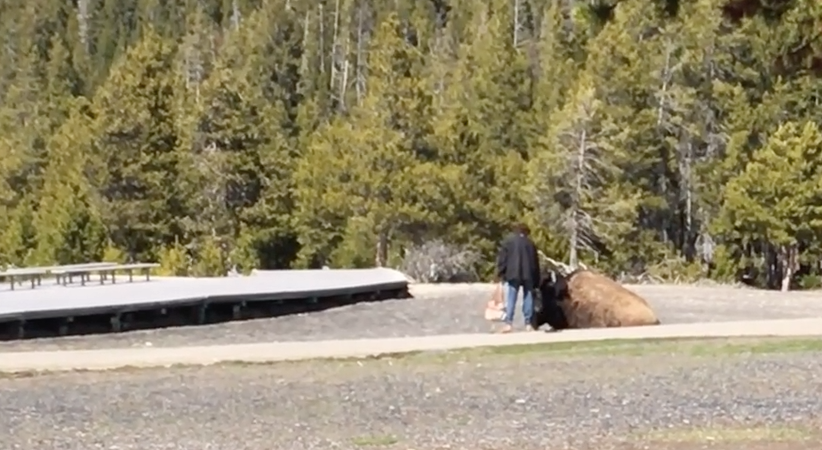T his is a public service reminder not to pet wildlife in national parks such as Yellowstone National Park, as one woman did when she pet a bison last week near Old Faithful Lodge during opening weekend.
Woman Pets Bison at Yellowstone National Park: Videos
There are two videos of the incident, which occurred on Saturday, April 16, 2016; and the videos are used with permission.
The first video — from Eugena True at ViralHog.com — shows one angle of the incident; and you can hear the astonishment and disbelief exclaimed from witnesses. “I just wanna go yell at her,” said one woman, “because, it’s people like her that just ruin it for everybody.”
The second video — from Brett Johnson at ViralHog.com — shows a different angle. At 0:32 in the video, the woman appears to drop something in front of the bison, who sniffs the unidentified object.
Although the woman was able to casually walk away unscathed, wild animals are unpredictable and can change their demeanor instantly — including being docile and appearing to not mind being pet before suddenly attacking the person who is doing the petting.
Official Regulations of Viewing Wildlife at Yellowstone National Park
Visitors of Yellowstone National Park are required by law to maintain a minimum distance from all wildlife, according to the official regulations of the park:
Wild animals, especially females with young, are unpredictable and dangerous. Learn about the hazards of visiting Yellowstone, including safety around bears, bison, wolves, coyotes, and ravens.
Do not approach bears or wolves on foot within 100 yards (91 meters) or other wildlife within 25 yards (23 meters). Keep a safe distance from all wildlife. Each year, park visitors are injured by wildlife when approaching too closely.
- Use roadside pullouts when viewing wildlife.
- Use binoculars or telephoto lenses for safe viewing and to avoid disturbing them. By being sensitive to its needs, you will see more of an animal’s natural behavior and activity. If you cause an animal to move, you are too close! It is illegal to willfully remain near or approach wildlife, including birds, within ANY distance that disturbs or displaces the animal.
- Watch our wildlife safety videos and see the power of large wild animals.
What Could Happen if Visitors are Not Careful
This video from 1992 illustrates a bison goring a visitor who approaches too closely — and the visitor highlighted in the video did not even attempt to pet the bison.
Bison can run greater than 30 miles per hour — roughly three to four times faster than an average human being. Outrunning a bison — especially one which is angry or is on the attack — is obviously not an option.
Summary
I visited Yellowstone National Park some years ago and enjoyed it immensely; and I may consider posting a retro trip report of my experience; but I would never consider petting a bison.
On the contrary, petting a bison — or any other wildlife — can be considered harassment, disruptive and disrespectful to the environment in general, as it introduces an unnatural experience which disturbs the routine of the animals. This is a reason why people are typically instructed not to feed wild animals, as it could lead to the animals depending more on food provided by visitors rather than hunting for their own sustenance.
One reason why national parks exist is to preserve the natural habitat of flora and fauna — especially species of which are considered endangered.
If the woman really wanted to pet an animal, there are plenty of petting zoos around the world which would satisfy her; but to take a chance as she did is simply pure foolishness.
Photograph from video used with permission — courtesy of Brett Johnson of ViralHog.com.

